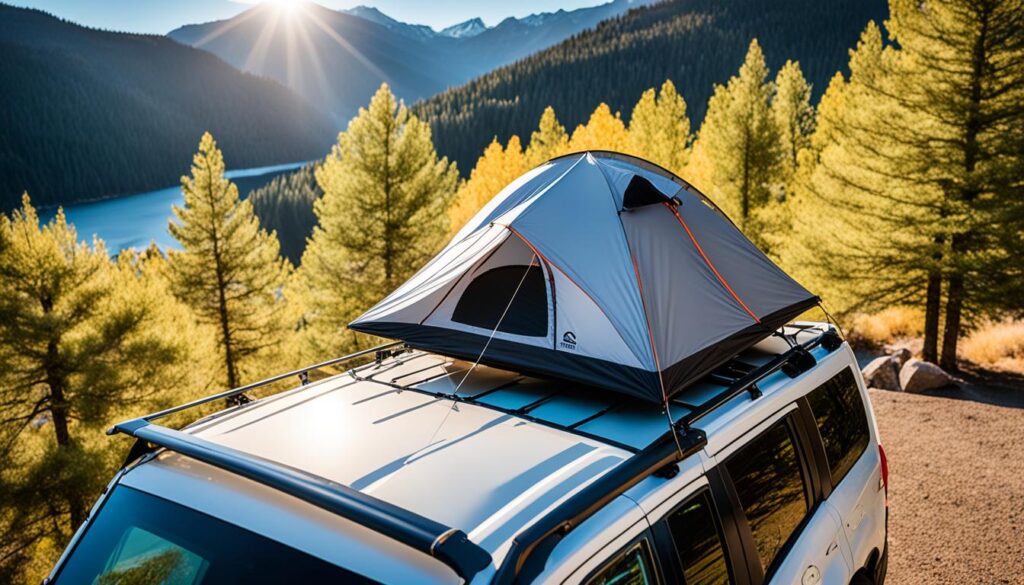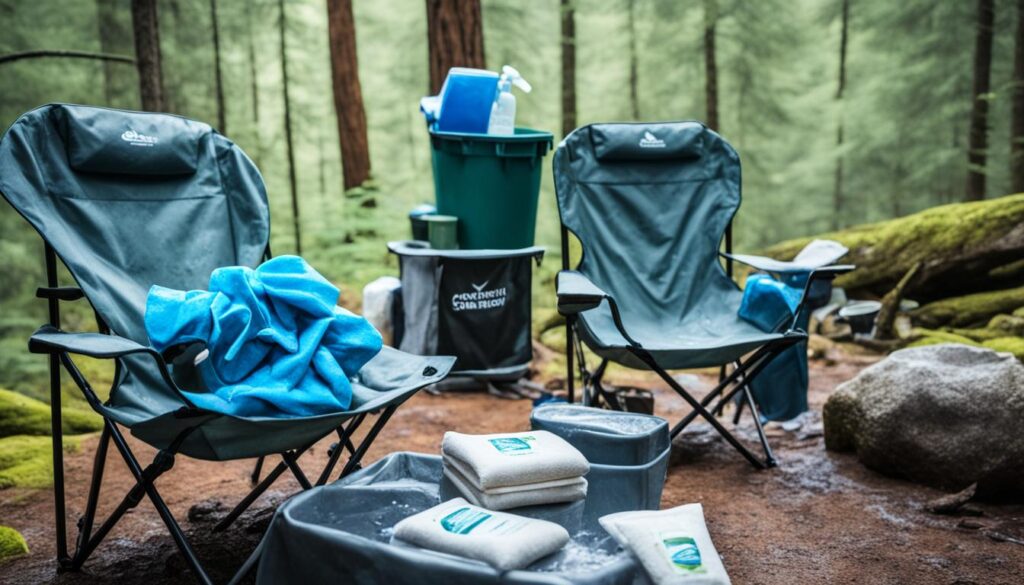Rooftop tent camping, also known as RTT overlanding, is a popular and exciting way to explore the great outdoors. It involves installing a tent on the roof of a vehicle, providing a comfortable and convenient sleeping space while on the go. This style of camping is ideal for adventure-minded individuals who enjoy off-road travel, outdoor exploration, and experiencing the thrill of wilderness camping. With the right gear and preparation, RTT overlanding offers the ultimate outdoor adventure.
Are you ready to take your camping experience to new heights? Discover the world of RTT overlanding and uncover the exhilarating possibilities awaiting outdoor enthusiasts like yourself.
RTT overlanding, also known as rooftop tent overlanding, provides numerous advantages over traditional ground camping. Whether you enjoy car camping or embarking on outdoor adventures, here are some key benefits of RTT overlanding:
- Elevated and Comfortable Sleeping Space: With a rooftop tent, campers can sleep off the ground on a sturdy mattress. This offers elevated comfort and convenience, especially for individuals with back or mobility issues.
- Maximized Storage Capacity: By utilizing a rooftop tent, campers can free up valuable trunk space. There’s no need to pack bulky tents and sleeping gear inside the vehicle, allowing for more storage capacity for other camping gear and essentials.
- Quick and Easy Setup: Rooftop tents are designed for easy and efficient setup and packing. This makes them ideal for spontaneous camping trips or quick weekend getaways, eliminating the hassle of setting up traditional ground tents.
With these advantages, RTT overlanding offers a convenient and comfortable camping experience, allowing outdoor enthusiasts to make the most of their adventures.
Different Types of Rooftop Tents
When it comes to rooftop tents for your overlanding adventures, there are two main types to choose from: soft shell and hard shell. Each type comes with its own unique features and benefits, catering to different camping preferences. Let’s take a closer look at the characteristics of each:
Soft Shell Rooftop Tents
Soft shell rooftop tents are constructed using durable canvas fabric and sturdy poles. These tents are known for their lightweight design, making them easy to install and pack up. If you’re someone who values quick and hassle-free setup, a soft shell rooftop tent would be a great choice for you.
One of the advantages of soft shell rooftop tents is their versatility. They often feature large windows and mesh panels, providing excellent ventilation and panoramic views of your surroundings. The canvas material also offers good insulation, keeping you comfortable in various weather conditions.
Although soft shell rooftop tents are generally more affordable compared to hard shell options, they may require additional maintenance, such as waterproofing treatments and occasional repairs.
Hard Shell Rooftop Tents
Hard shell rooftop tents are constructed using durable materials such as fiberglass or aluminum, offering enhanced protection against the elements. These tents have a sleek and compact design, making them aerodynamic and reducing wind resistance while driving.
One of the standout features of hard shell rooftop tents is their superior insulation. The hard shell provides better thermal performance, ensuring comfort even in extreme temperatures. Additionally, hard shell tents often come equipped with thicker mattresses, offering a plush sleeping experience.
Another advantage of hard shell rooftop tents is the internal storage options they provide. Many models come with built-in compartments and pockets, allowing you to organize and store your camping gear securely.
When choosing between a soft shell and hard shell rooftop tent, consider factors such as weight, ease of setup, insulation, and storage options. Assess your camping needs and preferences to determine which type of rooftop tent suits you best.

Considerations for Choosing a Rooftop Tent
When selecting a rooftop tent, there are several factors to consider. Firstly, you need to ensure that your vehicle’s roof rack is suitable for supporting the weight of the tent. It’s important to check the static and dynamic load ratings of your roof rack to ensure safe installation.
Next, you should consider the ease of installation and the time it takes to set up and pack down the tent. Some rooftop tents have faster set-up times than others, which can be beneficial for quick trips or frequent campsite changes. You don’t want to spend too much time struggling with complicated installation processes when you could be out enjoying your camping adventure.
Additionally, you may want to consider the availability and compatibility of accessories for your rooftop tent. Accessories such as annexes, awnings, or additional storage options can greatly enhance your camping experience by providing extra comfort, convenience, and organization. Before purchasing your rooftop tent, it’s important to research and ensure that the accessories you desire are compatible with the specific brand and model.
Lastly, it’s always a good idea to read customer reviews and consider the reputation of the brand when making your decision. Look for a reputable rooftop tent manufacturer that offers reliable customer support and warranties. This will give you peace of mind knowing that you’re investing in a high-quality product that will stand the test of time.
The key considerations for choosing a rooftop tent include:
- Suitable roof rack compatibility and load capacity
- Ease of installation and setup time
- Availability and compatibility of accessories
- Reputation and customer reviews
By carefully considering these factors, you can choose a rooftop tent that meets your specific needs and enhances your camping experience.

Tips for Successful RTT Overlanding
To make the most of your RTT overlanding experience, it’s important to follow some key tips.
- Ensure proper tent security: Before hitting the road, always make sure your rooftop tent is properly secured and latched. This will prevent any safety issues or damage to your tent while driving.
- Maintain weight distribution: Be mindful of the weight distribution within your vehicle to maintain stability and prevent potential handling issues. Properly distribute the load to ensure a safe and comfortable driving experience.
- Level your vehicle at camp: When setting up camp, it’s essential to level your vehicle to ensure a comfortable sleeping experience. Use leveling blocks or ramps to achieve an even surface for your rooftop tent.
- Optimize with accessories and gear: Make the most of your RTT overlanding adventure by utilizing accessories and gear designed specifically for this style of camping. Explore camping kitchens, storage solutions, and other equipment that can enhance your outdoor experience.
By following these tips, you’ll maximize the enjoyment and comfort of your RTT overlanding trips, creating unforgettable memories in the great outdoors.
Conclusion
RTT overlanding provides an unparalleled opportunity to immerse oneself in the wonders of the great outdoors. With the convenience and comfort of rooftop tents, outdoor enthusiasts can embark on thrilling adventures, exploring remote wilderness areas and embracing the freedom of outdoor exploration. By carefully selecting the right rooftop tent, considering installation and accessories, and following essential tips, campers can elevate their camping experience and create unforgettable memories during their outdoor adventures.
Adventure camping takes on a whole new meaning with RTT overlanding. The convenience of rooftop tents allows for off-grid travel and the ability to reach secluded campsites, far from the beaten path. Whether it’s waking up to breathtaking views, stargazing under the open sky, or simply reconnecting with nature, RTT overlanding offers an unmatched outdoor adventure.
So, gather your gear, hit the road, and embark on an unforgettable journey. Whether you’re seeking the thrill of outdoor exploration, the tranquility of wilderness camping, or the excitement of an adrenaline-fueled adventure, RTT overlanding is your gateway to experiencing the outdoors like never before. It’s time to embrace the spirit of adventure and create lasting memories amidst the beauty of nature.
FAQ
What is RTT overlanding?
RTT overlanding, also known as rooftop tent overlanding, is a style of adventure camping that involves installing a tent on the roof of a vehicle. It is a popular way to explore the great outdoors, enjoying off-road travel, and experiencing the thrill of wilderness camping.
What are the advantages of RTT overlanding?
RTT overlanding offers several advantages over traditional ground camping. It provides a comfortable and elevated sleeping space, freeing up valuable trunk space in the vehicle. Rooftop tents are also quick and easy to set up and pack down, making them ideal for spontaneous camping trips or quick weekend getaways.
What are the different types of rooftop tents?
There are two main types of rooftop tents: soft shell and hard shell. Soft shell rooftop tents are lightweight and easy to set up, while hard shell rooftop tents offer a more compact and streamlined design and provide better protection against the elements.
What should I consider when choosing a rooftop tent?
When selecting a rooftop tent, consider the compatibility of your vehicle’s roof rack, the ease of installation, and the availability of accessories. It’s important to ensure the tent is properly secured and latched before traveling.
What tips can you provide for successful RTT overlanding?
To make the most of your RTT overlanding experience, ensure your rooftop tent is properly secured, distribute the weight in your vehicle for stability, level your vehicle at the campsite, and make use of accessories and gear designed for RTT overlanding to enhance your camping setup.






